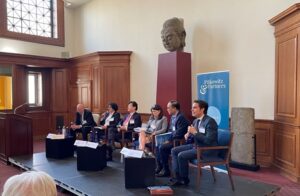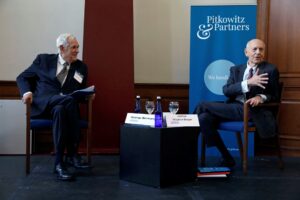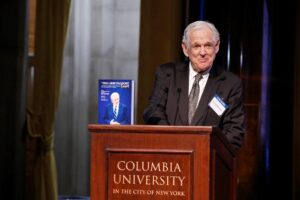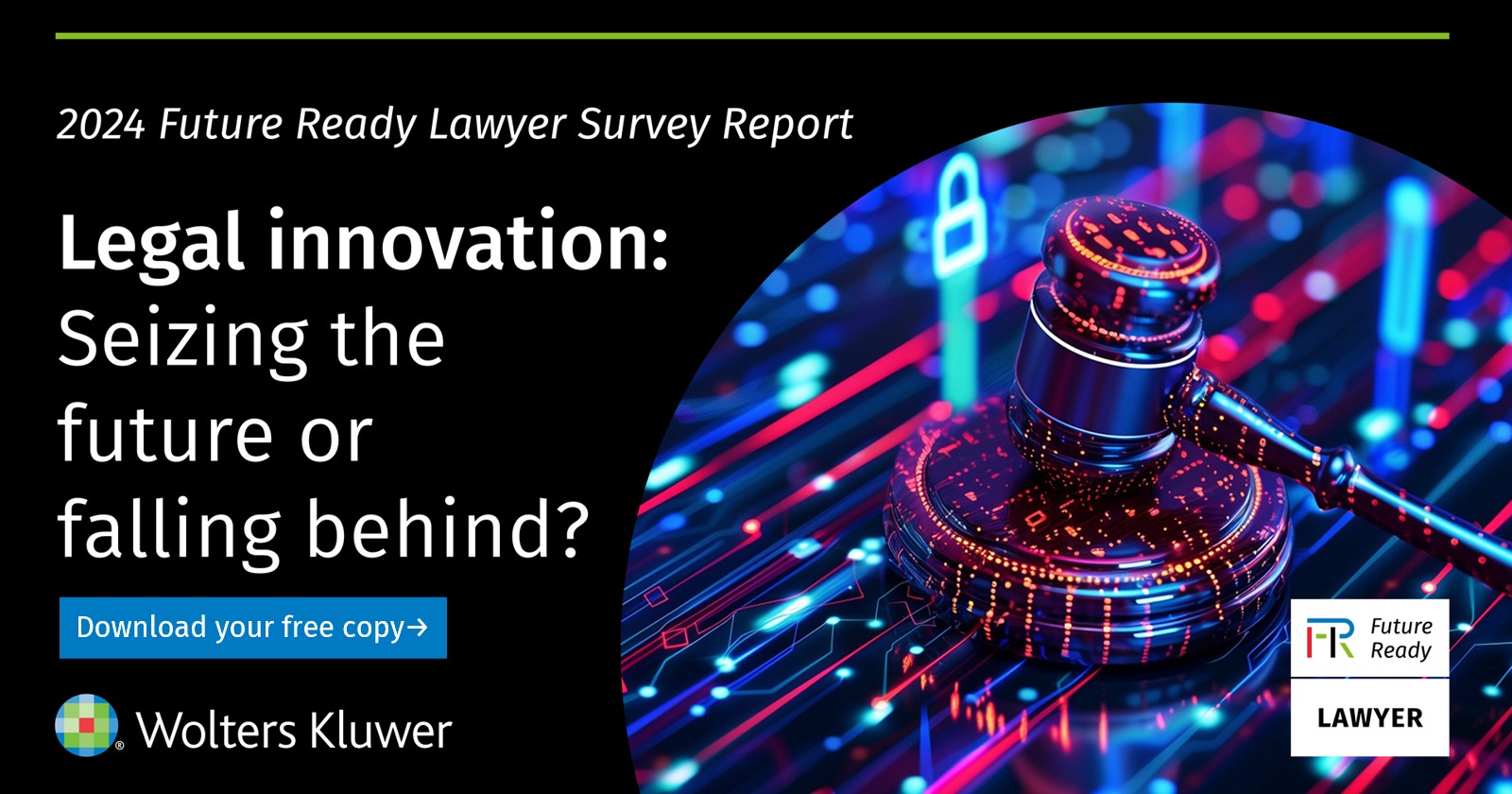Columbia Arbitration Day (CAD), held on April 14, 2023, enjoyed record attendance levels this year and was held in the historic Low Memorial Library, a fitting venue for the first in-person CAD since before the COVID-19 pandemic.
The Judiciary in International Arbitration Proceedings
The morning began with a panel moderated by Professor Alejandro Garro (Columbia Law School), which featured current and former judges discussing the role of the judiciary at key phases of an international arbitration proceeding. U.S. District Judge Lee H. Rosenthal (S.D. Tex.) kicked off the discussion by observing that the key questions faced by a judge when a party seeks to resist arbitration are: (i) is there an arbitration agreement; (ii) who does it bind; (iii) as to what issues; and (iv) which law will apply?
For Judge Rosenthal, the thorniest issue is what to do when there are factual disputes that are material to answering those key questions. Authorizing the parties to conduct limited discovery may assist, but that decision is inimical to the intent of the parties in selecting arbitration (if, in fact, they selected arbitration). The perpetual challenge in the field of domestic courts involved in international arbitration thus is how to strike an appropriate balance between getting the right answer to threshold/gateway questions and getting to the merits effectively, efficiently, and economically. The Hon. Shira A Scheindlin (Stroock) brought a unique perspective to the discussion as a former U.S. District Judge (S.D.N.Y.) and current arbitrator and mediator. Judge Scheindlin expressed continued hope that arbitration can be quicker and cheaper than court proceedings but cautioned that domestic court involvement frequently prevents this. Judge Elizabeth Stong (E.D.N.Y.) injected some levity into the discussion by noting:
“One of the opening questions we think about in this space is, who decides? But we don’t stop there. We then ask, who decides who decides? And then who decides who decides who decides? This, in a process that’s meant to be efficient!”
Judge Stong stressed that efficiency is as important in bankruptcy hearings, where there is never enough money and never enough time, as in arbitration: “‘The operation was a success, but the patient died’ is not a definition of success.” Finally, the Hon. Georg Kodek (Sup. Ct. Austria) provided a comparative perspective. Judge Kodek noted the uptick in adoption of the UNCITRAL Model Law on International Commercial Arbitration by European countries over the last 25 years. That uptick is officially attributable to various reasons, including ensuring party autonomy in arbitration. Unofficially, it is also to make jurisdictions more attractive as seats of international arbitrations. Speaking of the divergence in arbitrator practice post-Achmea, Judge Kodek expressed discomfort with those arbitrators who have stated that they do not feel bound by EU law. Such positions may result in greater court intervention. As Judge Kodek put it, “the readiness of arbitrators to comply with mandatory EU law may well influence the approach taken by the European Court of Justice when it is confronted with this issue again.”
Navigating Belt-and-Road Disputes

Professor Robert H. Smit (Columbia Law School) opened a fascinating panel on Belt-and-Road disputes by noting that, of his three-decade career in international arbitration, the first decade centered on Europe; the second on Latin America; and the third very much on Asia. Lianjun Li (Reed Smith LLP) provided an overview of the Belt-and-Road Initiative (“BRI”), the centerpiece of Chinese leader Xi Jinping’s foreign policy. When BRI launched in 2013, the goal was to involve 65 countries which together formed 65% of the world’s population. In the decade since, China has signed more than 200 cooperation agreements with 150 countries and 35 international organizations, representing almost 75% of the world’s population.
International arbitration appears ideal to resolve BRI disputes given most BRI states are Contracting States of the 1958 New York Convention. There are two practical concerns, however: (1) political implications of the disputes and (2) institutional capacity. Li posed the open question whether we need more institutions and bespoke rules to deal with BRI disputes. Existing institutions, such as HKIAC, CIETAC, ICC and SIAC, may all assist parties, but Li considers that Hong Kong is well-positioned to establish a court of arbitration specific to BRI disputes. For Li, Hong Kong has several key advantages: close proximity to mainland China; an independent jurisdiction under the “one country, two systems” policy; a reputation for arbitrator neutrality; multilingual legal practitioners trained in diverse jurisdictions; and a well-respected High Court.
Jingzhou Tao (Arbitration Chambers) spoke of two BRI-related initiatives: the China International Commercial Court, where Tao serves as a member of the Expert Committee, and the ICC Belt and Road Commission. One impediment to greater interest in the China International Commercial Court is that current rules prevent foreign lawyers from appearing before it. That is particularly relevant in light of the broad reach of the BRI, as explained by Yasmine Lahlou (Chaffetz Lindsey LLP) and Diana Tsutieva (Foley Hoag LLP). Thus, for example, while Lahlou noted that some say Brazil is outside of BRI, there is no geographic limit to BRI—its only limit is China’s strategic and economic interest. And with bilateral Sino-Brazil trade reaching US$ 120b in 2022, commercial disputes between parties from the two countries will likely increase. Tsutieva noted an increase in BRI activity between Uzbekistan and China since the Russian invasion of Ukraine. As a result, the Tashkent International Arbitration Centre (“TIAC”), founded in 2019, appears set to play a key role in resolving BRI disputes. Key to that is a 2022 exclusive cooperation agreement with HKIAC to adopt TIAC-HKIAC Cross-Institutional Arbitration Rules. In some instances, the two institutions will jointly administer cases. In others, TIAC will refer to HKIAC on certain procedural issues arising in arbitrations filed pursuant to the TIAC-HKIAC Rules. HKIAC will make its decisions without charging administrative fees except in limited, pre-defined circumstances. Simon Navarro (Sidley Austin LLP) extended the discussion of BRI to investor-state dispute settlement. Navarro noted that there is no unitary treaty that participating countries can sign up to specifically in relation to BRI disputes. Rather, there are two types of agreements: primary (state–state) and secondary (project-specific agreements). The former tend to be non-binding memoranda of understandings or intentions, or joint statements, and send strong political signals. For instance, Panama was the first Latin American state to sign BRI MOUs and severed diplomatic ties with Taiwan shortly prior.
Arbitrating ESG Disputes
Rahim Moloo (Gibson, Dunn & Crutcher LLP) moderated a discussion focused primarily on the “E” in ESG: environmental issues and related questions of regulatory space. Mélida Hodgson (Arnold & Porter LLP) noted that NAFTA included environmental protections in the form of art. 1114, but that post-Methanex the U.S. government felt the need for greater clarity, and so introduced an understanding in the 2004 Model BIT that non-discriminatory regulatory actions to protect the environment do not constitute indirect expropriations. For Ank Santens (White & Case LLP), the question of who bears the burden of environmental regulation is all about balancing risks and rights between sovereigns and investors, but noted that individual investors are more likely to obtain compensation when they alone are affected by environmental regulations, as compared to when they are part of a class of investors who are all affected. Guled Yusuf (Allen & Overy LLP) spoke of the evolution of BITs to include greater protection of ESG concerns, citing the text of the 2016 Morocco–Nigeria BIT as a recent example with relatively strong environmental carveouts. Amal Bouchenaki (Herbert Smith Freehills LLP) wondered whether such provisions might “chill” investments. From the various interventions made by the panelists it was clear that, despite increasing tension between investor rights and regulatory space, protections to preserve the environment are growing in investment arbitration.
Conversation on Innovating ISDS Proceedings

In keeping with the theme of “New Innovations and Perspectives”, Professor Kabir A.N. Duggal sat down with Meg Kinnear (ICSID) and Anna Joubin-Bret (UNCITRAL) to discuss recent innovations in the ICSID rules as well as the reform process underway within UNCITRAL Working Group III (“WGIII”). Using the metaphor of a house to describe the ISDS system, Joubin-Bret described WGIII’s work as not abolishing anything, but rather adding existing stories, wings, and doors to the house. The renovations appear very significant indeed. For instance, an “additional door” will be added to create a multilateral court to deal with EU investments. Another “story” will be added in the form of an appellate mechanism, which will apply not only to the court but to all investment arbitrations. Finally, procedural reform elements will be retroactively added “across the entire floorplan” to all existing treaties, on matters such as third-party funding, security for costs and damages. Such elements will be added to the circa 3000 existing treaties and will form part of a coherent package. When asked about the backlash against investor-state dispute resolution, Kinnear rankled at the term. “I hate the word backlash because it sounds like throwing the baby out with the bathwater.” For Kinnear, no other field of international law has developed so extensively in such a short period of time. Improvements can be made to the field, and the recent revision of the ICSID Arbitration Rules (covered on the blog here) is proof of that. “My bottom line is that I think the system works very well. It is a vital part of the rule of law and of encouraging investment.”
Fireside Chat: A Pro-Arbitration Legacy

The highlight of the day was a fireside chat between Prof. George A. Bermann and Justice Stephen G. Breyer (ret.) of the U.S. Supreme Court. Bermann began by asking, of Justice Breyer’s many accomplishments, which contributed most to his ascendancy to the Supreme Court, to which Justice Breyer humbly replied: “To be a federal court judge you have to get struck by lightning, and to be on the Supreme Court you have to be struck twice in the same place!”
Prof. Bermann noted that Justice Breyer is popularly characterized as a pragmatist, someone who values common sense and is sensitive to the real-world consequences of his decisions. In arbitration, we see this in two of Justice Breyer’s opinions:
- First Options v. Kaplan, 514 U.S. 938 (1995), which found that the presumptive power of the court to determine arbitrability flows from the fact that arbitration is simply a matter of contract between the parties and, if the parties did not agree to arbitrate arbitrability, then the court has to resolve that gateway question.
- Howsam v. Dean Witter Reynolds, Inc., 537 U.S. 79 (2002), which found that arbitrators could decide “procedural” arbitrability questions where it is likely the parties would have expected arbitrators to do so (with respect to, for instance, the timeliness of a claim).
For Justice Breyer, arbitration is ultimately a question of contract. Contractual principles, and particularly freedom of contract, shared by all states and federal law, should guide judicial review of arbitration agreements. His Honor ended the conversation with a prescription for all in attendance: “You better give your best to each thing you decide, all of the time. That, as you get older, is a greater and greater privilege.”
Tribute to A Towering Figure
The day ended with a sit-down dinner in the rotunda of Low Memorial Library and featured the launch of a festschrift in honor of Professor Bermann, “Pro-Arbitration” Revisited: A Tribute to Professor George Bermann from his Students Over the Years, as well as receipt by Professor Bermann of a Lifetime Achievement Award from the Columbia International Arbitration Association. In a fitting tribute to a man synonymous with international arbitration, speakers rose to the podium to praise Professor Bermann—for his love of arbitration; for his dedication to students over 47 years at Columbia; and for his service to the field of international arbitration as arbitrator, academic and expert. As Professor Smit noted: leave aside pro-arbitration, the Columbia community is resolutely pro-Bermann!

A defining feature of Columbia Arbitration Day is that it is organized entirely by student volunteers, led by J.D. Chair R. Daniel Knaap and LL.M. Co-Chairs Qianhe Gao, Jesús Saracho, Arshiya Sharda and Irene Whelan Vita. True to the theme of “new innovations and perspectives”, the conference brought together senior leaders of the arbitration community and the next generation of practitioners. Judging by the strong attendance, the diversity of perspectives shared, and the palpable sense of passion for the field, international arbitration is in good hands in the generations to come.
________________________
To make sure you do not miss out on regular updates from the Kluwer Arbitration Blog, please subscribe here. To submit a proposal for a blog post, please consult our Editorial Guidelines.


